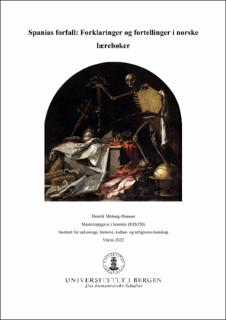Spanias forfall: Forklaringer og fortellinger i norske lærebøker
Master thesis
Permanent lenke
https://hdl.handle.net/11250/3001387Utgivelsesdato
2022-05-20Metadata
Vis full innførselSamlinger
- Master theses [215]
Sammendrag
In this thesis, I analyze the explanations and narratives of the decline of Spain in the early modern period as they appear in twelve upper-secondary Norwegian textbooks of history from the beginning of the 20th century until 2021. I examine these textbooks both in relation to general European historiography and the historiography of the decline of Spain as it has developed since the 16th century, and I make use of a range of analytical categories such as “actor-oriented perspective” and “structural-oriented perspective” to make sense of the explanations in the textbooks. I also rely heavily on both Hayden White’s and Jörn Rüsen’s typologies of narration to better understand how the textbooks may orient school children in the relation between past, present and future. One of my findings is that the representation of Spain’s decline in the textbooks has gradually transitioned from an actor-oriented perspective to a structural-oriented perspective. Textbooks in the beginning of the 20th century explains Spain’s decline largely in terms of the politics and ambitions of Philip II. After World War II an actor-oriented perspective is still present, but economic and social explanations are gradually gaining ground, thus reflecting larger trends within general European historiography. From the 70s and 80s a structural- oriented perspective predominates in the textbooks, and this trend has lasted up until today. However, all the textbooks are written from a liberal-protestant point of view, where myths of the so-called “Black Legend” inform the explanations and narratives. Another finding is that the narrative of the decline of Spain has moved like a pendulum between tragedy and satire. The textbooks in the beginning of the 20th century tell a story about “rise and decline”, but this narrative changes gradually after World War II where Spain is regarded as trapped by her own destiny. In the period between 2006 and 2021, the narrative transitions back to a story about “rise and decline”. In a broader story about Europe in early modern period, however, the narrative is consistently romantic and genetical in all the textbooks. Spain’s decline is the onset for Northern-Europe to dominate the scene. Especially interesting is the finding that Spain is almost always contrasted with the Netherlands. This representation also provides an exemplary and critical narrative, where the textbooks facilitate the values of democracy, tolerance and capitalism (with some moderation) in which Norwegian school children should orient their own life praxis. In this sense, Spain is regarded as an obstacle and school children should refrain from following its example. These explanations and narratives may have had consequences regarding the conceptualization of “Spanishness” in Norway, but this has to be studied further.
